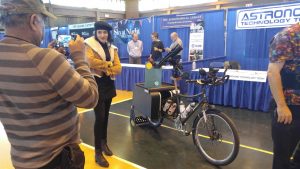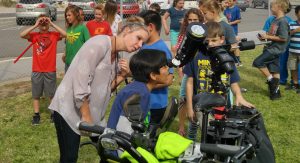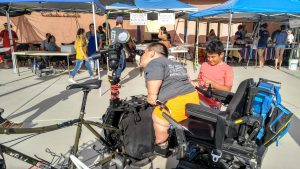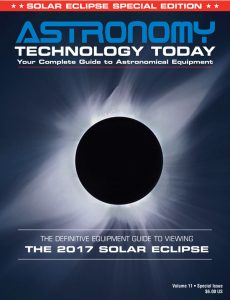By Gary Parkerson, Managing Editor of Astronomy Technology Today
Telescope Support Systems’ website describes the company as, “… founded by a pair of guys who live and breathe astrophotography. Between us, we have over 40 years of experience. While we currently shoot with CCDs and DSLRs, a peek in our storage lockers will reveal film and film cameras, hypering tanks, cold cameras and a slew of ‘stuff’ to aid in astrophotography. Over the years, we have both come to realize that eliminating differential flexure is one of the hardest things to get right (after getting proper focus).
Having access to state of the art CNC-machining equipment made it an easy decision to start designing our own support equipment. This let us see what works and what does not. Over the last few years, we have developed a system of tube rings and supports that are designed to be robust, lightweight and work extremely well. This is what we offer to you, our fellow astrophotographers.”
TSS’s product lines have grown quickly and now include exquisite camera mounts, clamp blocks, dovetail plates, guide rings, telescope rings, saddle plates, scope tails, and even a housing for all-sky cameras … none of which are covered in this article. What is covered is an example of something about which their website remains essentially silent: Custom telescope support solutions.

As I write this, I’m deep into a 48-state bicycle journey, carrying astro tech around the country with which to share views of the Sun with everyone I encounter along the way. There’s a total eclipse of the Sun coming, and this is how I’ve chosen to celebrate that greatest-in-my-lifetime astronomical event.
I ride a cargo bicycle by Surly Bikes, and I first demonstrated it in full mobile astro-lab mode at NEAF 2016 (Image 1). The configuration I came up with required that I remove the bike’s seat post and replace it with a hardwood dowel topped by a hardwood block onto which I fastened one of Sky-Watcher USA’s Star Adventurer micro-German equatorial mounts, which in turn supports a refractor equipped with a DayStar Quark.
So far, I’ve used three refractors with this set up: one of DayStar’s 80-mm achros, a Stellarvue SV70T apo, and a Explore Scientific’s carbon-fiber ES80EDTCF apos. At around five pounds, the SV70T and ES80EDTCF are both svelte, as high-end apos go, but they were still too much for the hardwood dowel to support when combined with the mount, Quark and an eyepiece. But I had no better solution, so was resolved to simply suffer through with the shaky setup … until the two fellows from TSS stopped by ATT’s NEAF exhibit.
They’re kind, those two guys, so they didn’t blurt the obvious weaknesses of my make-shift design. Instead, they congratulated me on a novel setup, and then set about quietly planning an improvement. The long and short of their reaction was, “We think we could do a little better. Do you mind if we take a few measurements?”

A couple of months later, I received a package from TSS care of a bike shop in Jefferson City, Missouri. I didn’t get to install the device they had created until I visited DayStar’s Warrensburg, Missouri headquarters, though, because I managed to lose a couple of critical screws the TSS team had included. The DayStar team replaced the lost fasteners from their ample manufacturing supply, and I first installed the assembly in the DayStar parking lot, as shown in Image 2.
I describe the custom TSS solution as an assembly, because it is. It is comprised of five main components: (1) a base, (2) a pivot block, (3) a riser, (4) a dovetail saddle and (5) a short Vixen-format dovetail.
The base of the assembly bolts/clamps onto the Big’s overlong frame between the seat post and its rear cargo area, and never leaves the bike. There’s a through hole on the front of the base through which a stainless-steel cap screw finds a standard threaded insert in the frame. The rear of the base is secured to frame by a clamp bar held by two cap screws.
Having gotten to know the TSS guys well over the years, I should not have been surprised that the base fit the frame so perfectly, but I was. After all, they only had minutes to take measurements at NEAF and have not seen the bike since, so were denied any trial-and-error wiggle room in designing this component. Yet, fit precisely it did.
The pivot block allows me to level the mount, even when the Big is set up on uneven ground. A single large stainless-steel cap screw squeezes the two sides of the pivot block against the top of the base member. I simply adjust the mount to level, then retighten the large cap screw.
The riser elevates the mount above the bike seat, allowing it to track without interference, and it was the screws that fasten the riser to the pivot block that I managed to lose at the bike shop in Jefferson City.

The riser is topped by an equally-custom dovetail saddle, which simply clamps the short dovetail in place with two thumb screws. The dovetail fastens, in turn, to the bottom of the little Sky-Watcher Star Adventurer mount with a single captive 1/4-20 socket screw.
The resulting mounting system is much more rigid than my original hardwood-dowel-and-block solution, and I’m no longer required to remove the bike seat before I can attach the mount and scope, which is a huge convenience.
But that’s not all the TSS guys planned into the system. I did not realize it when I first set the assembly up, but the guys calculated the mount height to not only be tall enough to clear the bike seat, and just low enough to be within reach not only of school age children (Image 3), but also to be within reach of those who must view from

wheelchairs (Image 4). And I’ve got to say, I’ve never been prouder of a couple of fellow astronomy nerds than when we made that latter discovery.
The point of all this isn’t that you should buy a bike and have TSS build a telescope support for yours, too. Heaven forbid! The Big is already one bicycle astro lab too many! My point is simply this: I did not know what I needed, but I knew the fellows at TSS well enough to trust that they would figure it out. And they did. A couple of photos and a few measurements taken amid the chaos of the busy NEAF expo floor were all they required. Well, that and a lifetime of experience at astronomy, high-precision machining and component design.
My telescope-support application was ridiculously one-off, but the TSS duo still made solving the challenge look easy, and the components they created look great. So, the next time you find yourself perplexed by your own novel telescope-support challenge, save yourself the stress. Contact the guys at TSS. You’ll be glad you did.
###
 The Astronomy Technology Today editorial staff would like to take this opportunity to remind you of the availability of our Solar eclipse equipment guide – The Definitive Equipment Guide to the 2017 Solar Eclipse. Our goal with the 40 page publication is to provide an easy-to-consume introduction to the technological options for viewing and imaging the Great Solar Eclipse. We cover the gamut of options available including building you own solar viewer, solar glasses, smart phones, DSLR cameras, using astronomy telescopes, solar telescopes, using binoculars, solar filters (including a DYI filter option), CCD astro cameras, astro video cameras, webcams and much more. You can view the guide on our website here – its free and there is no requirement to sign up to read the guide.
The Astronomy Technology Today editorial staff would like to take this opportunity to remind you of the availability of our Solar eclipse equipment guide – The Definitive Equipment Guide to the 2017 Solar Eclipse. Our goal with the 40 page publication is to provide an easy-to-consume introduction to the technological options for viewing and imaging the Great Solar Eclipse. We cover the gamut of options available including building you own solar viewer, solar glasses, smart phones, DSLR cameras, using astronomy telescopes, solar telescopes, using binoculars, solar filters (including a DYI filter option), CCD astro cameras, astro video cameras, webcams and much more. You can view the guide on our website here – its free and there is no requirement to sign up to read the guide.

